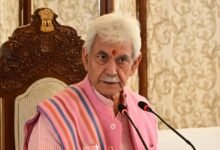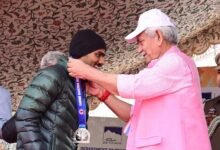*Supreme Court Sets 12-Week Deadline for JKCA Elections; Calls for Restoration of Transparent Cricket Governance*

Jammu, 02 November 2025: In what many see as a decisive push to rescue cricket governance in Jammu & Kashmir from more than a decade of power struggle, the Supreme Court has directed that the long-pending elections of the Jammu & Kashmir Cricket Association (JKCA) be completed within 12 weeks. The apex court has appointed former Chief Election Commissioner Achal Kumar Jyoti to conduct the process, strictly in accordance with the approved Constitution of JKCA. The Board of Control for Cricket in India (BCCI) has been ordered to immediately provide the formally approved Constitution, enabling the election exercise to begin without excuses or delay.
Significantly, the Court has also made it clear that the pending registration of the JKCA shall not be cited as a pretext to postpone or obstruct the electoral process. This means notification, nominations, scrutiny, polling, and declaration of results all need to be completed by mid-January 2026.
While the direction has broadly restored a sense of hope among players, clubs, and district units, the reactions on the ground remain cautious. The unresolved question haunting Jammu & Kashmir cricket is not about whether elections will happen, it is about whether they will be free from the influence of those who have entrenched themselves in decision-making without accountability.
For years, JKCA has been stuck in a cycle where the same small network of individuals either directly in power or influencing from the sidelines has controlled selections, finances, appointments, tour approvals, and even ground-level cricket activities. Stakeholders have pointed to the emergence of a system where proximity, patronage, and personal loyalty mattered more than performance, merit, or transparent process.
“Any democratic body collapses when one or two people start deciding everything,” said a senior club representative. Another veteran added, “The fear is not elections. The fear is manipulation of elections. Will those who enjoyed unchecked power allow a level playing field? That is the real test.”
All these concerns are not theoretical; they are rooted in lived experience. Over the years, several stakeholders have highlighted how a particular individual was allowed to rise into key cricket administration roles despite glaring red flags surrounding his credentials, age manipulation controversies dating back to under-16 competitions, and alleged fraudulent representations. An FIR in the past, ongoing dispute over eligibility, contradictory documents relating to birth year, and virtually no recognized contributions to cricket development have been pointed out by former cricketers and clubs. Yet the individual continued to enjoy influence, benefits, perks, and access to the cricketing machinery raising uncomfortable questions about who protected him, and why.
Such cases are not isolated. They reveal a deeper rot: a governance system driven by personal clout rather than rules. This culture has directly harmed cricket. Young players have routinely complained about opaque selection processes. Affiliated clubs have faced hurdles in even receiving recognition because, in several instances, membership technicalities were weaponized to disqualify clubs perceived as non-aligned to those in power. One club official bluntly stated: “Targeting clubs over documentation was never about regulations. It was about preventing democratic change and buying time.”
The consequences have been devastating. Many promising young cricketers have lost their critical competitive years because opportunities were controlled by private motivations rather than performance. Training infrastructure stagnated while funds existed. Selection camps seemed symbolic rather than serious. Even inter-district tournaments became predictable affairs where pre-decided names made the cut.
The Supreme Court’s order is therefore being viewed as more than just an administrative instruction, it is a constitutional intervention aimed at dismantling a system of concentrated power and restoring cricket to its rightful owners: players, clubs, and the sporting community.
However, fair elections alone will not solve the problem unless the electoral environment is insulated from influence. Three hard realities must be acknowledged:
1. The same influential persons who shaped the existing power structure are still present. They will attempt to remote-control outcomes.
2. Manipulation does not always happen openly. It occurs through candidate selection, intimidation, pressure on clubs, deals for votes, and misuse of access and may be even funds.
3. Unless stakeholders stay vigilant and refuse to be co-opted, the election may change names but not the system.
The Cricket in J&K now stands at a crossroads, either the apex cricket body transforms into a genuinely democratic and transparent body where merit decides selection, financial decisions are auditable, clubs are empowered, cricket activities in districts are active, and players are the centre of planning. Or the same old network will attempt to re-enter through the back door, ensuring that cricket continues to remain a preserved territory of a few rather than a platform for thousands of young athletes.
The Supreme Court has opened the door to reform. But it is the cricket fraternity including players, clubs, retired cricketers, and the community that must walk through it, united and determined.
The coming 12 weeks will decide whether cricket in JKCA finally recovers its dignity or whether the old playbook of influence, manipulation, and control finds new life under a new banner.
The choice is no longer administrative. It is moral. It is structural. And it will define the future of a generation of cricketers who deserve better.





